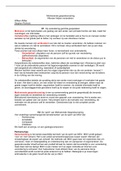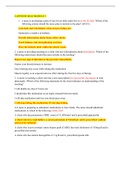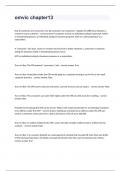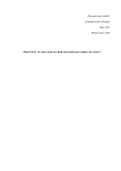Section 1: Monarchs and Parliaments, 1603-1629
Chapter 1: The Political Nation, the social basis of power and James I
The Monarch:
In the 17th Century, the monarch was the most important individual in the political
system. Through the prerogative courts, the monarchs could:
- Declare war
- Sign treaties with foreign ministers
- Call and dissolve Parliaments when they wished
- They could appoint a privy council to help see the day-to-day running of
things.
Despite this, the monarch did also face some restrictions:
- In order to pass legislation, a parliament had to be called and this meant that
MPs could scrutinise proposed laws. This could often lead to conflict and
division.
- The Monarch’s income was often not enough and especially in wartime,
monarchs would have to rely on parliament to approve new taxes to finance
the wars.
The Political Nation:
The political nation was the group of the population who could actively partake I the
political activity at national and local levels. Normally it comprised of nobility and
gentry and this group formed 1% of the population.
The social basis of power:
- Wealth and power was based on land ownership.
- There was a property qualification of approx. £2 a year and this meant that
poorer people wouldn’t get a vote.
James I:
Character: James came to the throne in 1603 after Elizabeth I dies. He was very
intelligent and wrote a number of books, including one on how to hunt witches and
was brought up on a Presbyterian faith. He was often very suspicious of threats to his
thrown because 8 months after his birth, his father was murdered and then his mother
was executed in the Catholic plots against Elizabeth. Despite being intelligent, he
was also very vain and he spent a lot of money on food and artwork, as well as having
a long trial of royal advisors.
Views on monarchy: James believed heavily in the Divine Right of Kings and he
even published a book in 1598 called ‘The True Law of Free Monarchies’. In this
book he made a number of statements, including:
1. God placed King on the throne and so he has unrestricted power
2. Kings are able to act above the law and aren’t subject to normal judicial
procedures
3. He saw parliament as something that served a monarch when it was required
and it didn’t play a large role in the political system.
,Chapter 2: Charles I: Character and views on monarchy
Character:
His character was shaped by his childhood experiences, for example in 1612, his older
brother Henry died and left him heir to the throne. Charles was clearly unprepared for
the role as monarch:
- He had a stammer and wasn’t a great pubic speaker
- Disapproved of his father’s extravagant courts
- Firmly believed in the divine right of kings.
His Views on Monarchy:
- Believed heavily in the divine right of kings – he commissioned a Dutch
painter to paint the ceilings at the Banqueting hall in Whitehall that depicted
James I ascending to heaven.
- He also believed that political power should lie with himself and a small group
of hand chosen advisors.
- He preferred an Arminian style of worship and began to appoint Arminian
chaplains that believed in the divine right of kings.
His Aims as King:
- Restore order to the royal courts
- Maintain firm control over his 3 kingdoms, England, Ireland and Scotland
- Secure his authority as Monarch
- Find a secure financial basis to respond to the debts from his fathers reign
- Maintain order in the church
Charles’ Favourites:
Just like his father, Charles would place complete trust in his advisors and would
consult them before making important decisions – this made parliament very worried.
Chapter 3: Financial weakness and reforms under James I
Underlying Problems:
Elizabeth encountered numerous financial issues just before her death in 1603 and this
meant that she would be running up a large debt and James inherited this debt in 1603
when he ascended to the throne.
James was also going to see financial issues because he had a family to look after and
support and the monarch’s income is already not sufficient.
Financial expedients during James’ Rule:
Financial Expedient What it did Successful or not?
Lionel Cranfield Lord Treasurer in 1621. Failed because
He attempted to reduce the Buckingham didn’t extend
crown’s spending and the reforms to himself.
increase its revenue.
He managed to reduce
James’ spending by 50%
Book of Bounty 1608 This attempted at reducing Failed because James gave
James’ finances by out cash instead.
preventing him from
selling Major assets such
as crown lands.
, Book of Rates 1608 Created Robert Cecil. He Failed - it only brought in
used the 1606 Bates’ case £70,000 a year
to create the book, which Increase on taxes led to
increased tariffs and levied fears about absolutism
impositions.
Great Contract 1610 Created by Robert Cecil in It was rejected by both
1610 to keep the chaotic James and the House of
finances of James in Commons
check. In return for an
annual sum of £200,000,
James would give up his
feudal rights.
Cockayne Project Suggested by Sir William Huge failure because
Cockayne. Planned British merchants didn’t
remodel of British Cotton have tech or skills to do it
industry and bring and so people wouldn’t
factories back to England. trade and so led to a trade
crisis in 1614.
Renewal of Monopolies Monopolies brought
money to the crown and
James used this to reward
his favourites.
Chapter 4: Financial weakness and reforms under Charles I
Economic inheritance:
When Charles inherited the throne of England, he also inherited his father’s debt and
he found that the Royal Treasury was virtually empty as a result of his father’s
spending. James had inherited a royal debt of £400,000 when he succeeded in 1603
and during his reign he thought nothing of spending tens of thousands on wardrobes
and favourites and pensions, which ultimately left Charles with very little
manoeuvrability.
The impact of foreign policy:
Charles had involved England in the 30 Years War on the Protestant side. His
commander in Chief (Buckingham) had led a number of foreign policy missions,
which all ended in failure and financial ruin. This led to growing concerns by MPs,
especially because Buckingham had such an impact of Charles. – This was one of the
main reasons for the influx of opposition against Charles in the 1628 Parliament.
Year of reign (Up to Personal rule, 1629) Problems faced
1625 Due to his financial problems,
Charles asked for a loan of
£600,000 from London merchants
Parliament wouldn’t grant Charles
tonnage and poundage for life and
this was customary for new
monarchs
Instead they gave him T&P for
one year – this helped him to
decide to dissolve Parliament.






